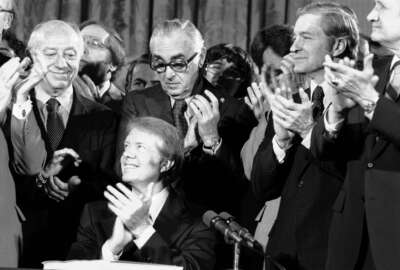VA’s ongoing problems started at the top, and they can end there
Taxpayers pay for two Veterans Affairs Departments, says Federal Drive host Tom Temin. There's the good VA, which reduces its backlog of disability claims. The bad...
Taxpayers pay for two Veterans Affairs Departments.
The good VA diligently reduced its backlog of disability claims, chipping a backlog of 611,000 cases down to 90,000 and still going. You can hear all about it in my interview with Allison Hickey, the undersecretary for Benefits.
The bad VA has 900,000 veterans waiting for health care services. The latest Office of Inspector General press release headline reads: “VA OIG substantiates whistleblower’s claims of extensive, persistent problems in veterans’ health enrollment records.” But investigators say they’re not sure. Because of bad record-keeping, the number could be as low as a mere half million. Employees accidentally deleted some records. Some veterans – nobody can figure out how many – died but their electronic traces live on. What a mess.

The good VA hires an chief “experience” officer from the fast food industry. Tom Allin is trying to change employees’ mind sets so they don’t think of themselves so much as bureaucrats or operators of complicated machinery as rather service representatives. He’s got an ambitious challenge on his hands. Lots of VA employees are dedicated to their mission. Veterans receive great care in millions of cases. But it doesn’t take many to spoil the system, both in reality and in the political and reputational repercussions.
The bad VA operates 1,000 web sites where veterans can head to try and find what they want. It continues with a patient scheduling system that’s old as the hills.
The good VA tries to get past these bottlenecks with a veterans.gov portal now in beta testing. It schedules deployment for this coming Veterans Day. It starts putting appointment requests in order of how urgent they are.
The bad VA builds – or tries to build – a gilded palace of a medical center in Aurora, Colorado only to have the project sink into a schedule and cost overrun scandal. The Army Corps of Engineers attributes the problems to the Integrated Design and Construction methodology the VA chose to use.
The good VA … well, the hospital saga continues. The Denver Post reports that the VA’s former national acquisition director was subpoenaed in the trial of an architect facing charges of paying a VA official in Cleveland for sensitive construction information.
A thread runs through all of these problems of the bad VA. Namely, management. In my interview, Hickey commented on how, when building computer applications to aid in the adjudication of disability claims, she worked directly with, as she put it, bargaining unit employees. They were the ones presented with modules as the contractor built applications piece by piece.
I’m sure you can find lots wrong with mid-level and bargaining unit employees, but they aren’t the ones who decided on a faintly-understood methodology for a hospital design-build. They’re not the ones who decided to launch a thousand web sites. And they’re not the ones who set the quotas and supplied the arcane scheduling system that left VA in such disarray that it brought down Secretary Erik Shinseki.
Also recall, whistleblowers, some in the rank and file, brought many of the VA issues to light so that the inspector general could investigate them. The Office of Special Council ruled on dozens of whistleblower retaliation cases at VA.
People like Secretary Bob McDonald, Allin, and Hickey seem to be setting the right tone. They face the challenge of making sure the rank and file have reason to believe they mean business about changing Veterans Affairs. And the leadership is obligated to back up their words with the tools to enable people to deliver what the VA promises.
Tom Temin is host of The Federal Drive, which airs 6-9 a.m., on Federal News Radio (1500AM). This post was originally written for his personal blog, Temin on Tech.
Copyright © 2025 Federal News Network. All rights reserved. This website is not intended for users located within the European Economic Area.
Tom Temin is host of the Federal Drive and has been providing insight on federal technology and management issues for more than 30 years.
Follow @tteminWFED







